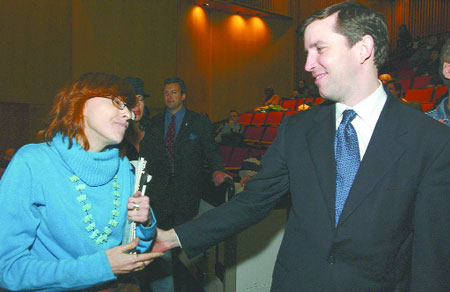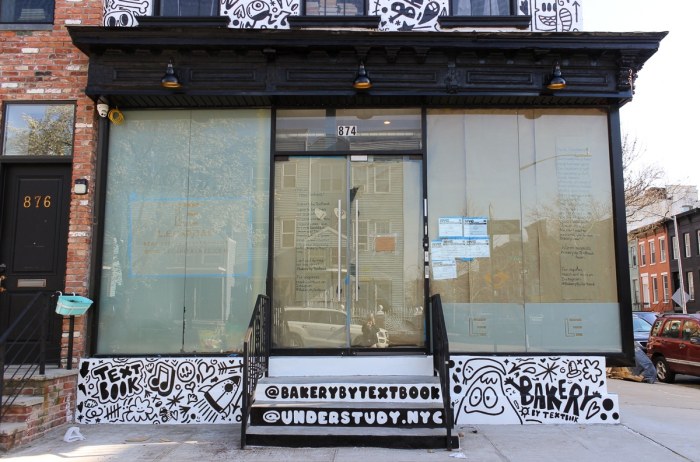By Albert Amateau
The months of worry for Independence Plaza North tenants appeared to have ended Monday when tenant association leaders reported an agreement with the owner, Laurence Gluck, who intends to take I.P.N. out of the Mitchell-Lama program at the end of June.
Nearly 500 I.P.N. residents at the March 8 meeting gave Neil Fabricant, the tenants association president, a standing ovation when he said, “Nobody is ever going to have to leave because of not being able to afford living here.”
The jubilation was based on the assumption that the 22-page agreement between Gluck, who acquired the 1,329-unit complex last autumn, and the tenants association, would be signed soon.
Nevertheless, as late as Thursday afternoon, March 11, Fabricant said “There’s still tweaking to be done by lawyers.” And Maureen Connelly, a spokesperson for Gluck, said on Thursday that negotiations had not ended. Both, however, remained confident that the deal would be done.
At the March 8 meeting, Fabricant introduced City Council Speaker Gifford Miller, sponsor of a Council bill that would make it expensive and difficult for landlords to leave the Mitchell-Lama affordable housing program. Fabricant said the bill, which was heard in October and re-introduced by Miller, last month in the new Council session, had contributed to the agreement by putting political pressure on the landlord.
The standing ovation that greeted Miller, a likely candidate to run against Mayor Bloomberg in 2005, included shouts of “mayor — Miller for mayor.”
Fabricant credited Ethan Geto, tenants association consultant, and attorneys Allan Epstein and Arlo Chase of Manatt, Phelps & Philips, with key roles in the negotiations that will affect the estimated 3,500 people who live at I.P.N. Fabricant also cited Chad Marlow, a lawyer and political activist in the Village, for writing an early version of the Council bill.
Under the agreement, all tenants must apply for enhanced federal vouchers, known as sticky vouchers, available for projects exiting the Mitchell-Lama program. Eligible tenants of record who earn less than 95 percent of family median income — $41,000 for a single person and $60,000 for a family of four — will receive vouchers and pay 30 percent of their income for rent. The federal Department of Housing and Urban Development, which funds the voucher program and will determine who is eligible, will pay the landlord the difference between the voucher rent and market rate.
Gluck has previously estimated that two-thirds of I.P.N. tenants would be eligible for vouchers, to be administered by the city Department of Housing Preservation and Development.
Tenants living in the 300 or so apartments not eligible for vouchers will be in a city-regulated Landlord Assistance Program, which will set their rents at the present levels. Yearly increases for the first nine years will equal increases set by the city Rent Guidelines Board, the agency that annually sets rents for rent-stabilized apartments. In the 10th, 11th and 12th years of a LAP tenant’s residency, the rent will be what the Rent Guidelines Board decrees plus 3.5 percent. After that, the rent will be the Guidelines Board rent plus one percent.
But unlike renters in stabilized buildings, LAP tenants will not go to market rents when their rent exceeds $2,000 per month.
Voucher tenants must also conform to appropriate apartment-size geared to the size of their families. But, for example, if a couple whose child has grown and moved out are in a two-bedroom apartment but belong in a one-bedroom, the landlord must find them an appropriate-size apartment at I.P.N. or permit them to live in the bigger apartment and absorb the difference in rent.
Despite their elation at what has been called the best deal of any tenants in the city in projects leaving Mitchell-Lama, I.P.N. tenants groaned at the prospect of parking fee increases phasing up to market rate in five years.
Under the agreement, voucher tenants will remain in the voucher program and continue to pay 30 percent of their income regardless of how much their income increases. “So I guess if you’re a voucher tenant and begin making $200,000 a year, you might want to move,” Fabricant quipped. LAP tenants will also remain in the LAP program even if their incomes fall below 95 percent of median family income.
If any tenant leaves an I.P.N. apartment, that unit will go to market-rate rent. However, under the agreement, blood relatives and registered domestic partners already living in an apartment for the previous two years will be able to inherit the apartment at the agreed rents.
“This agreement is permanent and doesn’t end as long as you’re in I.P.N.,” said Fabricant to another burst of applause. Gluck has also agreed to make long-needed physical improvements in the complex without imposing rent increase for major capital improvements, Fabricant said.
The big uncertainty is the future of sticky vouchers. The Bush administration’s proposed budget for next year would restructure the entire federal housing subsidy system. While a spokesperson for HUD said last month that the proposed new system would cover as many tenants as the present one, critics say the new system would cover far fewer people over the next nine years.
Fabricant said on Thursday that he has been warning I.P.N. tenants for three years that federal housing subsidies are never a sure thing. But he recalled that former H.P.D. Commissioner Jerilyn Perine testified before the City Council in October that the vouchers would be available for eligible tenants. “Both H.P.D. and HUD came to a tenant meeting last month with Gluck’s lawyers to explain the vouchers,” Fabricant said. “They said that some kind of voucher system has been in place for 30 years and told us not to worry,” he added.
Nevertheless, Fabricant told the March 8 meeting that the next lobbying effort will be to get the city and state to support the vouchers if the federal subsidy lapses.
I.P.N. board members and tenants on Monday hailed the deal but there was still some anxiety.
“I guess vouchers are really a catch 22,” one tenant said during the open question and comment period on Monday, worried about the future of the program.
“I hate to be a hazer, but for tenants who pay a surcharge now, will the base rent include the surcharge,” asked another tenant using the Yiddish word for pig. The answer was yes.
Although board members declared the deal “unprecedented,” other former Mitchell-Lama projects established a pattern. Heywood Tower tenants on the Upper West Side at Amsterdam Ave. and 91st St., a 188-unit residential building that left the program last year, have a similar agreement with their landlord, Seavey Organization. Glen Gardens, a development on 87th St. and Amsterdam Ave., which also left the program, also has a similar agreement.
Tenants at Land’s End 1, a 251-unit Mitchell-Lama rental building on Clinton St. on the Lower East Side, are negotiating with their landlord, Starrett Corp., who plans to leave the Mitchell-Lama program. Lands End 1 tenants are also counting on sticky vouchers to subsidize rents.
But tenants at West Village Houses, the complex of 42 low-rise buildings with 420 apartments, have a tougher problem. They too are talking to their landlord who intends to leave the program, but according to Katy Bordonaro, a tenant leader, the complex was completed before 1974 and therefore not eligible for sticky vouchers.
Albert@DowntownExpress.com
Reader Services


















